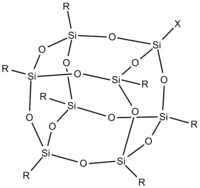Hydrogen silsesquioxane

Hydrogen silsesquioxane(s) (HSQ, H-SiOx, THn, H-resin) are inorganic compounds with the empirical formula [HSiO3/2]n. HSQ was first reported in 1970 by Dow Corning.[1] Typically, the cubic H8Si8O12 (TH8) is used as the visual representation for HSQ. The composition of Dow’s HSQ was investigated by vapour phase chromatography (vpc), nuclear magnetic resonance (NMR), and infrared spectroscopy (IR).[1] Dow Corning reported further composition investigations, via field desorption (FD), desorption chemical ionization (DCI) mass spectroscopy, and matrix-assisted laser desorption/ionization (MALDI).[2] The preparation, separation, and analysis [elemental analysis (EA), gas chromatography–mass spectroscopy (GC-MS), IR, and NMR] of TH8, TH10,TH12, and TH14 was reported, albeit in low yields (<5%).[3]
HSQ is primarily used as a negative resist in photolithography and electron-beam (e-beam) lithography. The use of HSQ as a negative resist was first reported in 1998[4] and widely investigated in the 2000s. HSQ is commonly delivered in methyl isobutyl ketone (MIBK) and can be used to form 0.01–2 µm films on substrates/wafers. When exposed to electrons or extreme ultraviolet radiation (EUV), HSQ cross-links via hydrogen evolution and Si-O bond formation. Sufficiently dosed and exposed regions form a low dielectric constant (low-k) Si rich oxide that is chemically resistant/insoluble towards developers, such as tetramethylammonium hydroxide (TMAH). Sub-10 nm patterning is achievable with HSQ and a collection or practical knowledge for using HSQ is provided by Georgia Tech 1 and Yale 2. The nanoscale patterning capabilities and low-k of the Si rich oxide produced is useful for a broad scope of nano applications and devices.[5]
HSQ has been available as 1 and 6% (wt%) MIBK solutions from Dow Inc. (Formally Dow Corning), called XR-1541-001 and XR-1541-006, respectively. HSQ in MIBK is known to have a short, problematic shelf life. Alternatively, Applied Quantum Materials Inc. (AQM), a Canadian company, manufactures HSQ as a powder (or made-to-order solution) with a longer shelf life 3.[6],[7]
References[]
- ^ a b Frye, Cecil L.; Collins, Ward T. (1970-09-01). "Oligomeric silsesquioxanes, (HSiO3/2)n". Journal of the American Chemical Society. 92 (19): 5586–5588. doi:10.1021/ja00722a009. ISSN 0002-7863.
- ^ Chen, Huiping; Tecklenburg, Ron E. (October 2006). "Characterization of low and intermediate molecular weight hydrogen silsesquioxanes by mass spectrometry". Journal of the American Society for Mass Spectrometry. 17 (10): 1438–1441. doi:10.1016/j.jasms.2006.06.010. ISSN 1044-0305. PMID 16872839.
- ^ Agaskar, P. A.; Day, V. W.; Klemperer, W. G. (1987-09-01). "A new route to trimethylsilylated spherosilicates. Synthesis and structure of [Si12O18](OSiMe3)12, D3h-[Si14O21](OSiMe3)14, and C2v-[Si14O21](OSiMe3)14". Journal of the American Chemical Society. 109 (18): 5554–5556. doi:10.1021/ja00252a058. ISSN 0002-7863.
- ^ Namatsu, H.; Yamaguchi, T.; Nagase, M.; Yamazaki, K.; Kurihara, K. (1998-03-01). "Nano-patterning of a hydrogen silsesquioxane resist with reduced linewidth fluctuations". Microelectronic Engineering. International Conference on Micro- and Nanofarbication. 41–42: 331–334. doi:10.1016/S0167-9317(98)00076-8. ISSN 0167-9317.
- ^ Chen, Yifang (2015-03-05). "Nanofabrication by electron beam lithography and its applications: A review". Microelectronic Engineering. 135: 57–72. doi:10.1016/j.mee.2015.02.042. ISSN 0167-9317.
- ^ Shen, Jiashi; Aydinoglu, Ferhat; Soltani, Mohammad; Cui, Bo (2019-03-01). "E-beam lithography using dry powder resist of hydrogen silsesquioxane having long shelf life". Journal of Vacuum Science & Technology B. 37 (2): 021601. doi:10.1116/1.5079657. ISSN 2166-2746.
- ^ Jiashi, Shen (2018-09-28). "E-beam Lithography using Dry Powder HSQ Resist Having Long Shelf Life and Nanogap Electrode Fabrication".
{{cite journal}}: Cite journal requires|journal=(help)
- Optical materials
- Materials stubs